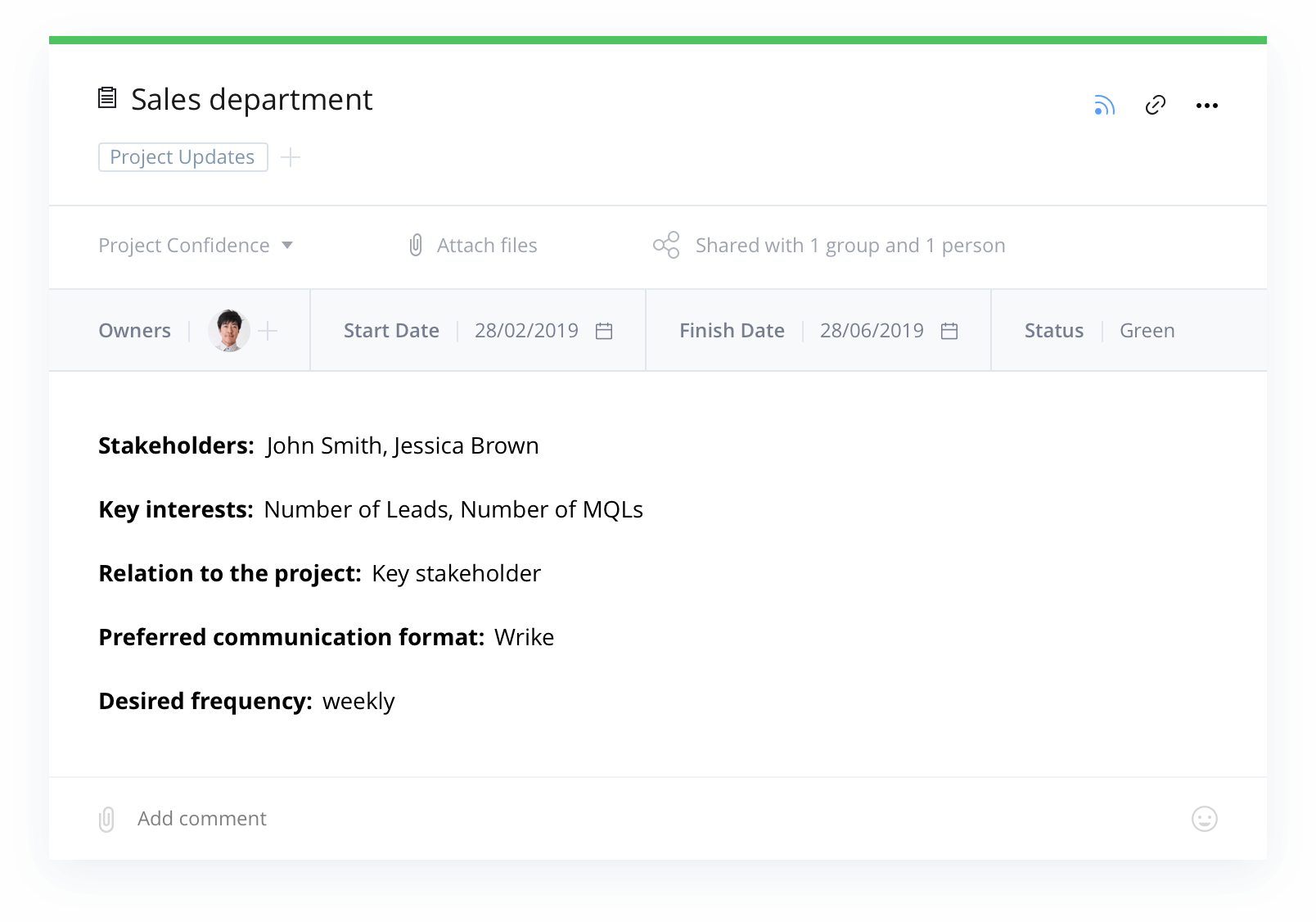What Is Project Communication Management?
Project communication management is a crucial aspect of project management as it ensures all stakeholders are kept informed about the project’s progress, issues, and changes, thereby facilitating effective decision making and collaboration.
In this guide, we’ll explore project communication management in depth, covering everything from the creation of a communication plan to strategies for successful implementation.
Before we begin, you can unlock a free trial with Wrike right now to communicate and collaborate effortlessly in real time.
What is project communication management?
Project communication management is a collection of processes that help make sure the right messages are sent, received, and understood by the right people.
Project communication management is one of the 10 key knowledge areas in the PMBOK (Project Management Book of Knowledge). The processes included in this area have changed over the years but, in the current version, there are three primary project communication management processes.
These are:
- Plan communications management
- Manage communications
- Monitor communications
How to create a project communication management plan
To effectively manage communication across projects, project managers must create a communication management plan. Here are five essential steps to guide this process:
- Decide your objectives: Define the purpose of your communication. For instance, some messages may be aimed at raising awareness (like status reports), while others may require action (such as obtaining approvals).
- Determine your audience: Identify all stakeholders involved in the project. This includes team members, sponsors, customers, and any other interested parties who may influence or be affected by the project’s success.
- Write your message: Clearly articulate what will be communicated for each type of message. Key components include scope, schedule, budget, objectives, risks, and deliverables.
- Choose your channel: Select the most appropriate method for delivering your message. Options may include formal reports via email or informal verbal updates during team meetings.
- Set a timeline: Establish when messages will be delivered. Consider whether stakeholders need weekly or monthly updates and account for different time zones and schedules.
Your project communication management plan should be detailed enough to lay out why you’re sending a message, who you’re sending it to, what specific information will be sent, how you’re going to send it, and when.


Involving stakeholders in creating this plan is essential to understand their preferences and expectations for communication. Over-communication can lead to disengagement, while under-communication can result in misunderstandings.
The golden rule here is that, to be a good communicator, you need to be a good listener. It may seem obvious, but Harvard Business Review points out that listening is an overlooked leadership tool. Pay attention to all the factors and take every opinion into account before creating your project communication management plan.
Manage project communication
Once the project communication management plan has been created and approved, it’s the project manager’s job to ensure it’s carried out successfully. This means the plan needs to be reviewed and updated on a regular basis to reflect any changes to the project or its stakeholders.
The project manager also has to manage the execution of the project communication management plan. This includes:
- Collection and analysis of data
- Creation of messages for communication
- Transmission or distribution of communications
- Storage and retrieval of communication reports, files, or documents
- Disposal of outdated communications upon project closure
Note: A study by McKinsey & Company found that improving communication and collaboration through digital tools can increase productivity by up to 25%.
Monitor project communication
This process involves overseeing and controlling communications throughout the entire project lifecycle. Effective monitoring ensures that:
- Communications go out as planned
- Messages reach the intended stakeholders
- Recipients understand the messages
- Relevant feedback is provided to project members
The actual type of monitoring, including method and frequency, should be a part of the project communication management plan.
Manage and monitor communication effortlessly in one platform
How to be successful at project communication management
According to the Project Management Institute (PMI), poor communication is one of the main reasons a project can fail, highlighting the critical importance of effective communication management.
Successful project managers use formal and informal communication methods across various channels. This helps increase the chances that messages are received. Use simple language, stick to relevant topics, keep messages concise, and include all information in one place to reduce your chances of communication failure.
The following communication management skills can also increase a project manager’s chances of success:
- Strong active listening skills
- Proficient writing skills
- Excellent speaking ability
- Asking questions and probing for more information
- Setting and managing expectations
- Motivating people to become and stay engaged
- Conflict resolution skills
- The ability to summarize and recap what you’ve heard
Why use Wrike for project communication management?
Communication is the backbone of project management. A structured approach to project communication management ensures that information flows seamlessly among stakeholders, reducing risks and enhancing collaboration. By leveraging modern tools and best practices, project managers can navigate the complexities of today’s projects with confidence and clarity.
Wrike’s project management platform is a powerful tool for project managers. It’s intuitive, easy to use, and versatile enough to be tailored to your specific project needs. Wrike also has a variety of features that can help project managers increase and improve communication throughout their various project stages.
These include:
- Custom request forms: By automating requests, project managers can efficiently communicate task requirements in seconds, and add extra information in custom fields.
- @mentions: Tag a team member to send a notification directly to their Wrike inbox. This ensures that no messages are lost in unread emails.
- Integrations: Keep all your project communication on one platform by integrating Wrike with your favorite messaging apps, including Slack and Microsoft Teams.
- Live Editor: With this tool, you can edit task descriptions in real time, meaning several people can communicate changes quickly with each other. This is especially useful for remote teams working together on a group project.
- Calendars: Share updates in team calendars, so that everyone is kept in the loop. Edit project deadlines and due dates easily.
Take a tour of Wrike’s work management platform and find out how you can boost your project communication management.
So, why not embrace the principles of project communication management and harness the power of Wrike? Doing so can significantly enhance the success rate of your projects, leading to satisfied stakeholders, a motivated team, and a thriving business.
Further reading:
- 4 Reasons Why Communication Fails (And What To Do About It)
- 6 Strategic Ways to Keep Your Team Communication Streamlined
- 5 Most Common Mistakes in Managing Multiple Projects: Communication Breakdown (Part 5 of 5)
- 5 Ways to Save Your Team from Communication Breakdowns
- The 5 Ws of Virtual Communication

Artem Gurnov
Artem is a Director of Account Development at Wrike. He previously held the role of Project Manager, overseeing a team of customer success managers (CSMs). Over the years of building teams and scaling business processes, he has successfully deployed multiple projects, from automating client outreach to setting up work prioritization tools for sales reps and CSMs.


